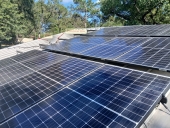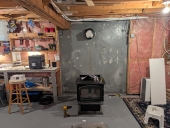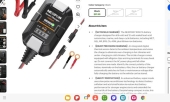


Yup, the use case for lead is shrinking all the time. It has proven to be a game changer for many people.Aaron Yarbrough wrote:
David Baillie wrote: Lithium is a game changer as well as you can get full array production since they have low resistance to charging unlike lead and you don't waste time at the high voltage low amperage low production absorb stage. It has forced solar designers to change their ways as we now maximize panel numbers due to low panel costs as our first priority. On the down side you are usually best to repanel completely so you can maximize your strings and the all in one inverters are terrible at lead acid charging as they lack a proper 3 stage charging profile.
We woke up with no power a few weeks ago. One our 6V FLA batteries had a bad cell I think. Fortunately, I had recently received a lithium battery kit and was almost finished assembling it so we we didn't have to limp along for long. The difference between the FLA battery bank and the Lithium Phosphate one is amazing. We're still getting summer temperatures here(two months out from the winter solstice) and I'm running two mini splits, a convection oven, an induction cooktop two fridges and it seems like I can't run the battery out of power. Then with 2-3 hours of full sun it's back to 100% charge. I ordered more solar panels which I will still install but it definitely appears like the weak link of my system was my battery.

Based on the wett inspections I've had done for clients everything looks good. Is the horizontal pipe leading to the chimney going to be double walled? If not you will want to double check your clearances to the Minisplit tubing. I assume your floor is concrete? If so you are good as you need 18" of non combustible floor in front of the stove. Good luck on the Wett inspection.Sheldon Caulfield wrote:Hey all! I'm in a mad rush to install my new woodstove before the winter.
This is going in my unfinished basement, and you'll see in the attached photo that there are some soft mini split/heat pump tubes and cords strung across the top of the wall directly above the wood stove.
I'm having someone in for the final inspection in a weeks time so that I can safely burn, but it's $350 for the inspection so I really don't want to fial and have to book another one.
Does anyone think those tubes would be a problem? Additionally, are there any other glaring problems you guys can see around the stove that I'm blind to? (Except for the fact that the stove isn't hooked up to the chimney of course, lol)
I've always liked the water analogy for explaining power to people. I usually use pressure for voltage, flow for amperage, and volume for watts... Its not perfect but it gets the point across to people.Miikee Mike wrote:Hi folks. I was very confused by all those heavy electronics videos when i wanted to learn about Voc Isc and Bypass Diodes so i made a video that uses easy water analogies to explain it. It has a follow up video at the end screen going into reverse biased and forward biased Bypass Diodes and strings. They're just meant to get some ideas across. Feel free with feedback or questions.
YouTube
I'll let you look that up. I suggest you not do that with a portable floating neutral inverter for safety reasons.Crinstam Camp wrote:
David Baillie wrote: I would suggest then disconnecting the light circuits from the larger panel if possible and powering them using plugs.
Exactly how would one go about powering circuits from a separate inverter without disconnecting them from the main panel???
Crinstam Camp wrote:
David Baillie wrote:I would suggest you look into low wattage LED bulbs then. The conversion efficiency on any inverter will be at its absolute worst in the first 20-30 watts. What are you lighting up? I've had good success with the USB based low wattage bulbs. Your conversion efficiency will be much better stepping down in DC from 12 to 4.5 than stepping up from 12 volt to 120ac. Or any of the 12 volt led lighting out there. At the scale you are talking conversion will kill you. All that depends on your application of course.
Cheers, David
I assume you meant to say low wattage DC bulbs?
Most of our lights are all double bulb fixtures with a 1 watt LED in one side and a pull switch socket with 2 Watt LED in the other. Just wandering through and turn on the switch and the 1 watt comes on, need more light? Pull the cord and the 2 watt comes on.
We aren't going to run new lines for DC lines to power the lights.
Our lights are all going to be on their own 12v bank of two 100Ahr batteries and 300 watts of panels. The little amount we will lose with a inverter is small, I just want it as small as possible lol
It started because we aren't supposed to hook 6 of our batteries in parallel for some reason that I'm still not clear on lol
I figured instead of just letting them sit here until we got two more we might as well use them.
But when I started thinking about it, I realized how much better it would be.
If the other bank drains, or the main inverter takes a dive, we're left in the dark. This way that doesn't happen.
Plus we have three 100 watt panels, that we were using as our main ones until we got the new 200 watt panels, that are now just sitting here along with the charge controller we had then. This way it all is still getting used.
I would suggest you look into low wattage LED bulbs then. The conversion efficiency on any inverter will be at its absolute worst in the first 20-30 watts. What are you lighting up? I've had good success with the USB based low wattage bulbs. Your conversion efficiency will be much better stepping down in DC from 12 to 4.5 than stepping up from 12 volt to 120ac. Or any of the 12 volt led lighting out there. At the scale you are talking conversion will kill you. All that depends on your application of course.Crinstam Camp wrote:
David Baillie wrote:
Just generalities. Make sure its a pure sine wave inverter for efficient energy conversion and smooth running of your devices. Modified sine can heat up transformers and fry certain battery chargers on tools. I like the small wattage Victrons for durability; they have a 250 watt unit. Samlex is another good small inverter brand, renogy is so so, then you get into the take a chance ones on amazon.Crinstam Camp wrote:I'm looking for the most efficient 100 watt inverter (12vdc to 110vac) I can find.
Any suggestions?
Cheers, David
All it will be powering are 1 and 2 watt LED bulbs up to a maximum of 40 watts in total. The normal would likely be closer to 6 to 10 watts
Just generalities. Make sure its a pure sine wave inverter for efficient energy conversion and smooth running of your devices. Modified sine can heat up transformers and fry certain battery chargers on tools. I like the small wattage Victrons for durability; they have a 250 watt unit. Samlex is another good small inverter brand, renogy is so so, then you get into the take a chance ones on amazon.Crinstam Camp wrote:I'm looking for the most efficient 100 watt inverter (12vdc to 110vac) I can find.
Any suggestions?


you would need to pull up the specs on the secondary battery not the all in one unit. It will tell you the charge voltage and you program your victron for that voltage.Rico Loma wrote:David , I wanted to send this again, please refer to specs on my all in one unit. Internal battery is very small. My only question at present is how best to chargethe battery shown here, it is 100Ah 12v battery, LFP chemistry. Would you advise using AC power for a smart charger designed for LFP battery? If not, 0lease explain.